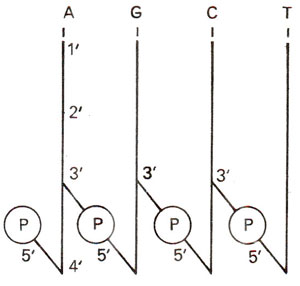Polynucleotide

Fig. 25.14. A short hand notation of a polynucleotide with four nucleotides : (1' to 5' represent numbers of five carbon atoms of pentose sugar).

Fig. 25.13. A polynucleotide chain showing phosphodiester bonds.
A polynucleotide chain (Fig. 25.13) would have a direction so that, if it starts from C3, it would _ end in C5 and if it starts from C5 it would end in C3. Normally, therefore, whether we are referring to a mononucleotide or else to a polynucleotide we should indicate the groups present at C5 end and at C3 end. It could be either a phosphate group or a hydroxyl group. For instance, 5'p3'OH dinucleotide would mean that it is a polynucleotide with only two nucleotide units and has phosphate group at the 5' end and a hydroxyl group at the 3' end.
A short hand notation of a polynucleotide (or oligonucleotide) with a constitution 5'AGCT3' or 5'pApGpCpT-OH3' is shown in Figure 25.14. This is a very convenient method to write nucleotide sequences with 5' terminus on the left and 3' terminus on the right side. In this notation the vertical lines represent the pentose sugar with 5 carbon atoms.




